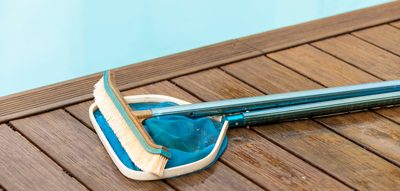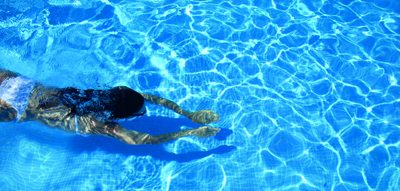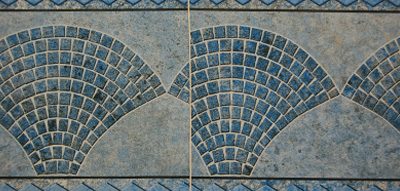CARE AND MAINTENANCE OF AQUAFLEX PRE-TAILORED SWIMMING POOL LINERS
Introduction
While guarantees on prefabricated liners vary from manufacturer to manufacturer their life expectancy is generally in the region of 7 to 10 years provided that the swimming pool is operated within standard care and maintenance schedules.
Prefabricated liners are made undersize to allow for a crease free stretch fit. This stretch fit causes the liner to stand away slightly from the pool walls in the corners of rectangular pools, especially near the water surface and above. It is impossible to damage the liner in these areas without using a sharp instrument as the liner material has a stretch factor of approximately 250%. Due to undersizing, liner walls can sometimes run into the floor area. It is therefore important that the pool owner is made aware of this possibility.
As a result of this high stretch factor, it is not possible, during manufacture, to align the pattern between the strips of material that make up the liner. It is important to bear this in mind, particularly when ordering liners with a regular pattern. Similarly, great care must be taken when ordering a liner with a different colour base from the side wall for a pool where the wall to floor join is uneven as the resulting “wandering join” will be unsightly.
Fitting liners
Before fitting the liner check that the sizing, colour, pattern, gauge and specification of the liner is correct.
- Make sure the interior finish of the pool shell is smooth and free from sharp projections. When screeding or plastering the pool shell, use soft sand, not sharp sand.
- Pressure test the pool pipework. Should there be a problem of leaking later, the pipework will have already been eliminated.
- Sweep out or vacuum the pool shell ensuring that it is clean and free of leaves, sharp objects and any other debris.
- If the pool is indoors, check that no paint or varnish has accidentally splashed over the prepared screed as residual solvents in these materials can discolour the liner.
- Wash the pool walls and floor with a 100ppm solution of Sodium Hypochlorite to kill any micro organisms that may be present in the pool shell. (These micro organisms can, if allowed to multiply, cause the liner to stain). After removing the deconcentrated washings of Sodium Hypochlorite from the pool, the shell should then be painted with a fungicide solution which will help to prevent the further growth of micro organisms.
- If the temperature is below 10oC (50oF) we recommend that the fitting is postponed until warmer weather prevails. Conversely, do not attempt to fit the liner between 100 hours and 1500 hours on hot, sunny days as the heat of the sun will cause the liner to stretch under its own weight. Further fitting difficulties will also be encountered as, inevitably, one section of the liner will be in shade and therefore be less supple than the areas in direct sunlight.
- Ignore packing creases – they will disappear but this may take up to two weeks in cold weather.
- Always leave the liner in its box when lifting into the pool, having first examined the box for signs of transport damage. If the box is damaged, check if the liner has also been damaged. Protect the liner from any sharp edges within the pool shell with felt or suitable masking tape.
- Unroll and locate the deep end marker on the liner. This marker will indicate the deep end of the liner. Always remove this label and discard it. Failure to do so can cause a stain to appear through the liner several months later.
- When fitting patterned liners take great care not to scuff the pattern with hard soled footwear. Try to fit liners in bare feet or at worst, wear soft soled plimsolls. Avoid the use of trainers as their soles are often quite hard.
- Check all pool fittings have new gaskets – do not reuse old gaskets.
- Tack in small sections of the liner beading into the retaining linerlock fixed to the pool shell just below the coping stones. Using the corner labels on the liner beading as a guide, find the four corners of the pool and fit a small section of beading either side of the corner. Then find the mid point along each side and each end and fit a small section of beading at these points. This method of fitting will:-
(a) Lift the liner side wall clear of the base to allow you to see if the base of the liner is positioned correctly.
(b) Have the effect of distributing the beading evenly around the pool.
(c) If the liner has to be repositioned in the linerlock slightly, it makes it easier to adjust.
- When you are happy with the positioning of the base of the liner, push fit all the beading into the linerlock. Overlap liners can be adjusted as the pool fills with water, although care must be taken to ensure that the base of the liner is orientated correctly in the pool shell before any water is introduced.Vacuum fit the liner by introducing an industrial vacuum cleaner hose between the pool shell and the liner, sealing all points of leakage with paper masking tape. This vacuum will pull the liner back towards the pool shell to enable you to ascertain if any wrinkles are likely to be held in the liner should the pool be filled with water.If, under vacuum, the liner contains wrinkles that are unlikely to disappear, the liner either needs to be re-positioned or it may be the wrong size or shape for the pool. Should this occur, immediately consult the manufacturer.
If you are not happy with the fit of the liner, do not proceed further and do not cut any fittings.
- While filling the pool, do not turn the vacuum off until there is at least 3” of water over the base of the pool at its shallowest point. Always cut side wall fittings at the last possible moment, preferably when they are just beneath the water level as the pool fills. Early cutting of fittings can lead to creasing of the liner when the pool is full. When fitting the liner to Roman End step units ensure that the base to side wall joint of the liner is not positioned too far away from the shallow end wall of the pool.
- When fitting liners with steps tailored in, always fit the step area of the liner first and ensure that the stepped area of the liner is fitted snugly to the pool shell steps.
At this point vacuum the liner as normal and at the same time cover each step tread with sand bags to hold the step section in position. Without sandbags the weight of the water, as it fills the pool, will drag the liner out of position on the steps. As each step tread is covered with 100mm of water then remove the sandbags from that step tread.
General Liner Care
- A liner pool should be kept full of water at all times. If the pool is emptied, the liner may move out of position.
- Leaves or other debris should not be allowed to lie on the pool floor for long period of time as they may stain the liner.
- When adding any pool chemicals to the pool water always make sure that the circulation pump is kept running to thoroughly disperse the chemicals. The time needed for total dispersal varies from pool to pool, but it is necessary to circulate the entire volume of pool water through the pump at least once. Always read the dosing instructions on chemical packs. Never exceed the recommended doses stated.
Most pool chemicals are heavier than water and if they are not dispersed, simply sink to the bottom of the pool and lie against the liner in concentrated form. This will inevitably damage the liner.
Treat the pool water with one chemical at a time and never mix different chemicals together. Dilute or completely dissolve all chemicals in a bucket of water prior to adding to the pool. Always add chemicals to water, not water to chemicals. Never use your hand to stir chemical solution. We do not recommend that you put chlorine tablets or sticks into the skimmer as bleaching of the liner may occur when the filter pump is turned off. Never scatter dry chlorine directly onto the surface of the pool water. Doing so will result in bleach spots on the floor. Treat all chemicals with respect – fire and explosion or release of dangerous gas can result without warning if handled improperly. Store all chemicals in a dry, safe and secure location by type. All chemical containers should be tightly sealed when in storage.
We recommend that liquid chlorine is only added to liner pools by professional pool engineers.
- Scum line dirt should be cleaned off on a regular basis using a proprietary brand of liner tile band cleaner. Do not use abrasive materials to clean the scum line as these will remove the pattern or printed liners and roughen the surface of plain liners. We do not recommend the use of acid based cleaners as these will discolour the pool liner. If fatty/oil based scum line deposits are not removed regularly then they will destabilise the liner pattern and print loss will result.
- Do not allow the pH level of the pool water to drop below 7.2 as this will have a damaging effect on the liner. If the pool water pH level rises above 7.8 then the water is too alkaline and calcium deposits on the liner surface may occur. An ideal pH level for the liner is between 7.2 and 7.6. Your water test kit will show a free chlorine residual level or the amount of chlorine available to kill bacteria in the water. Your free chlorine residual level should be between 0.3 and 1.0 ppm (parts per million). If free chlorine drifts below 0.3 ppm algae and bacteria will grow more easily and may cause liner staining. If chlorine levels are consistently above 1.5 ppm the pH levels are regularly below 7.2 excessive moisture absorption will occur and this will cause the liner to wrinkle. This aggressive water balance will also cause print loss from the liner.
All PVC lined pools must be routinely stabilised with cyanuric acid in a range between 30 ppm and 70 ppm. A level of less than 30 ppm combined with a pH level of less than 7.0 and/or a chlorine level higher than 3.0 ppm can cause the liner to form wrinkles. Do not use large single doses of hydrochloric (muriatic) acid for pH or total alkalinity adjustment. If it is not blended sufficiently with the pool water it may chemically attack the liner’s print pattern. Ask your pool dealer for the recommended procedure for total alkalinity adjustment.
Your water test kit, or your dealer’s test will show a total alkalinity reading. Simply put, this is the ability of your pool water to counteract the changes in the pH level. Ideally, the total alkalinity level should be at 100-175 ppm.
Calcium levels should be kept at a minimum level of 200 ppm to avoid corrosive conditions. Calcium levels over 500 ppm may cause problems such as cloudy water or scaling on the liner surface.
- Provided that water chemicalisation is maintained correctly within the pool, the liner will give good service at water temperatures of up to 85oF (30oC).
At temperatures in excess of 85oF (30oC) the life expectancy of the liner can reduce progressively from the normal 7-10 year life down to as little as three years. However, experience shows that provided the chemical balance of the pool water is maintained correctly and consistently, then the liner will perform satisfactorily at temperatures well in excess of 85oF (30oC). As with all things, the greater the care, the longer the life.
- All cleaning equipment used in the pool such as brushes, vacuum heads and automatic cleaners must be specifically designed for liner pools. Use care when brushing the liner. Ensure the pool brush and pole do not have any sharp edges that could tear the pool liner.
Note: Automatic pool cleaners that remain trapped in one position can damage the pool liner – never leave them unattended for long periods.
- When winterising the pool, always ensure that all debris is removed from the pool water and that any chemicals added are thoroughly dispersed.
At the end of the pool season adjust the water level to the dealer’s recommended level. Test the pool water and correct the water balance. NEVER close a pool without circulating the pool water for several hours after the final addition of chemicals – chlorine may settle in the deep end and bleach the liner if not allowed to thoroughly disperse in the pool water. Clean and vacuum the pool. Use a well fitting winter pool cover, tightly sealed around the perimeter of the pool.
This will prevent the accumulation of debris such as leaves and insects during the winter. Should you have any problems with your pool, call your dealer – he is your pool professional. And remember, that proper chemical balance, regular maintenance and common sense are the keys to years of enjoyment from your pool.
Distortion of Liners
Because of their elasticity and moisture absorbency characteristics it is possible for liners to crease even when full of water.
Creasing caused by low co-efficient of friction (liner slip): stretching of a liner
Whilst heavy bathing loads, steep slopes, felt or foam underlay and high water temperatures can contribute to liner movement, the fundamental cause is almost certain to be an equalisation of water pressure inside and outside of the liner, i.e.: water trapped beneath the liner.
Should liner movement caused by foot traffic take place at any time during the life of the liner always initially look for water build up behind the liner as this is most likely to be the cause. It is essential that the shell of a liner pool is totally permeable and that the pool site is generally free draining. It is essential that a facility for de-watering the pool shell is incorporated into the pool structure at the build point. If this facility is provided, then high water table sites for liner pools cease to be a problem. Should creases in the liner need to be removed, this can be accomplished by pouring boiling water over the area of liner that has been stretched by foot traffic (not the crease). This operation can only be carried out with water removed from the pool and a small amount of air introduced behind the liner to enable it to move back to its original unstretched form. It is recommended that the above procedure is carried out by a professional pool engineer and the pool water lowered by the minimum amount and for the shortest period of time.
Creasing caused by chemical imbalance : growing of a liner
Liner material is affected by its environment and absorbs moisture and water treatment chemicals. In normal swimming pool conditions, absorption will not exceed 5% of the original weight of the liner but with high temperatures and low pH, total absorption could reach much higher levels.
The huge weight of pool water that is standing on the liner ensures that it remains in place even though it has a tendency to grow. Only when the absorption levels within the liner have become so great that they exceed the water pressure will the liner move and start to crease.
Moisture absorption
Temperature and pH of the swimming pool water have a major effect on liner absorption. The absorption will make the liner material want to swell. As long as the liner cannot slip on its support (and form creases) only its thickness will increase. An absorption up to 5% is normal and will not provoke any wrinkling. In order to avoid excessive absorption, pH should never be lower than 7 and temperature not above 30oC (85oF).
| Growth of material causes creasing | Water treatment conditions, (pH, temperature, pollution of water, level of water treatment chemicals) determine the level of absorption and thus the growth of the liner. This has a major influence on creasing. |
| Lower friction
causes creasing |
Concrete floors or those covered with a felt have a normal friction co-efficient while smooth surfaces such as metal or plastic wall panels, have a lower resistance to slip as a small film of water can easily build up between the liner and the panel. |
| Rigidity of liner causes creasing | High levels of chemicals and/or incorrect pH will make the liner less flexible. This raises the internal tensions and increases the risk of creasing. |
| Water trapped behind liner causes creasing | The amount of water that is pressing the liner against its support also has an influence on the risk of creasing; more important though is the amount of water present behind the liner as this not only compensates the pressure of the water inside the pool but also can decrease slip resistance of the liner. |
If creasing has occurred mainly due to poor water treatment, then the distance between creases will be small (1cm to 15cm). However, when the pool shell has low resistance against slip or when there is a significant quantity of water trapped behind the liner, the distance between creases will be greater (more than 30cm).
With the foregoing facts in mind, it is possible to evaluate the cause of the wrinkling when inspecting a problem pool. Some typical examples:-
(a) The liner has wrinkled and discoloured around the pool sump
The distance between folds is quite small and the estimation of total growth of the liner gives a very high level of moisture and chemical absorption. This kind of wrinkling indicates that the material has been severely attacked by chemicals. When chemicals are thrown directly into the pool and are not correctly dispersed, they tend to concentrate on the deepest part of the pool which creates, locally, very high concentrations of chemicals. When slow dissolving tablets are placed in the skimmer, they continue dissolving even when the circulation pump is not working. If this situation continues over a long period, the chemicals will find their way through the pipe work and will enter the pool at the bottom outlet. This also creates high chemical levels in the deepest parts of the pool. Chemicals should always be thoroughly mixed with water in a bucket before being added to the pool water.
(b) There are creases on the floor and/or wall beneath skimmers, lights and water inlets
In this case, estimation of liner growth gives a lower value than previously described but is still considerable. The distance between creases is also greater. In this instance, the liner has grown due to excessive chemicals (often accompanied by discolouration) or high temperature (no discolouration). However, this alone is not enough to cause wrinkling. It is likely that water has accumulated behind the liner. This has lowered the slip resistance of the liner against the pool shell which has allowed creases to form. The liner material on the walls resists creasing a little better as this material is stretched when put into the pool but with the liner on the floor growing and forming creases, the wall material has moved upwards which then creates folds beneath the skimmer and inlets. After the ground or trapped water has dissipated the creases will remain.
Discolouration of Liners
Staining
Liners do not stain by themselves. There is always an outside agent causing the staining. Probably the most common form of liner staining is that caused by bacteria or micro organisms growing behind the liner. The gases given off by these bacteria/micro organisms permeate through the membrane and react with dissolved metals in the pool water (copper, iron) causing staining on the visible side of the liner. Fortunately, this type of staining is not permanent. If the cause of the staining is removed, then the stains will gradually fade and eventually disappear. There are two ways of tackling the problem. One is to destroy the bacteria/micro organisms behind the liner with chlorine which means emptying or part emptying the pool in order to gain access to the areas in question. This is not always desirable. The other method is to remove the dissolved metals from the pool water so the gases permeating through the liner have nothing with which to react. This can be achieved by the use of Alkorplus 81059.
Bleaching/Fading
The main cause of liner fading above the water line is UV light. Liner material contains additives which will resist UV degradation but they can only do so much. Slight fading will start to occur from day one as can be noticed if a patch of virgin material is applied six months after the liner was installed. After the first three or four years, the rate of fading can increase noticeably.
Liner material will take on a slightly paler appearance when is absorbs moisture below the water level. This is noticeable when the water levels drops suddenly. The full colour will return when the material dries out. Keeping the pool covered when not is use and maintaining correct water chemistry will help to extend the appearance and life of the liner.
A more dramatic form of colour fading is that caused by chemical attack (bleaching). Common culprits are chlorine (in its liquid form especially), acid and hydrogen peroxide. It is vital that any chemicals added to the pool be thoroughly mixed with water in a bucket and then dispersed evenly around the pool.
Whilst the print on patterned liners is protected by an acrylic lacquer, it is possible to mistreat the liner is such a way as to remove some of the lacquer and print, leaving the base material visible. The most common causes of this are abrasive tile band cleaners, incorrect footwear during liner fitting, sharp edges on telescopic poles, brushes, etc., and automatic pool cleaners if they have become trapped in one position (usually a corner) for too long. A rough screed under the liner can result in print abrasion or even holes. Never leave automatic pool cleaners unattended for long period.
Surface deposits
Perhaps the most common forms are calcium deposits (usually caused by incorrect pH balance) and body/sun tan oils. Apart from the obvious discolouration to the liner, calcium deposits may well be an indication of more serious damage being done to pumps and heaters etc. Other surface deposits include wind borne chemicals from adjacent farms or aviation fuel and occasionally sticky deposits from some biguanide sanitisers.
Guarantee for Prefabricated Domestic Swimming Pool Liners 0.5mm (20 thou) & 0.75mm (30 thou)
5 Year Limited Guarantee
Should any material fault or manufacturing defect covered by this guarantee become apparent within 12 months of purchase, the pool liner will be repaired or replaced free of charge.
If such a fault occurs at any time during the following 4 years then the value of the guarantee shall be pro rata from the date of purchase – ie: the purchaser will be required to pay the full list price of the liner at the date of the claim less 1.60th of that price for each full month remaining in the guarantee period. This guarantee is non transferable and is applicable to the original purchaser only.
Conditions
This guarantee covers:-
- Defects in liner materials and faulty workmanship where the liner has been installed correctly by competent persons in a suitable pool structure and operated under normal domestic conditions – (see care and maintenance instructions).
This guarantee does not cover:-
- Pool liners that have been subjected to alteration, misuse, abuse, neglect, accident or flood.
- Damage caused through incorrect chemical balance. Chemical levels must be kept within the levels recommended by their manufacturers. Very high levels of water sanitizers will cause the liner to fade and creasing of the lining material may occur.
- Pools that operate at water temperatures in excess of 30oC (85oF).
- Pool liners that have been drained of water other than by a competent pool fitter.
- Liners installed on sites with a high water table or underground springs without a professionally installed dewatering system.
- Pool liners installed on rough or incompatible pool shell surfaces.
- Misalingment of liner patterns. The flexible characteristics of the liner material makes it impossible to align the pattern on the material during manufacture.
Exclusions
- No liability for consequential costs or incidental damage arising from a defective pool liner will be accepted.
- No liability will be accepted for any damage to property or injury to persons or animals caused directly or indirectly by the pool liner.






